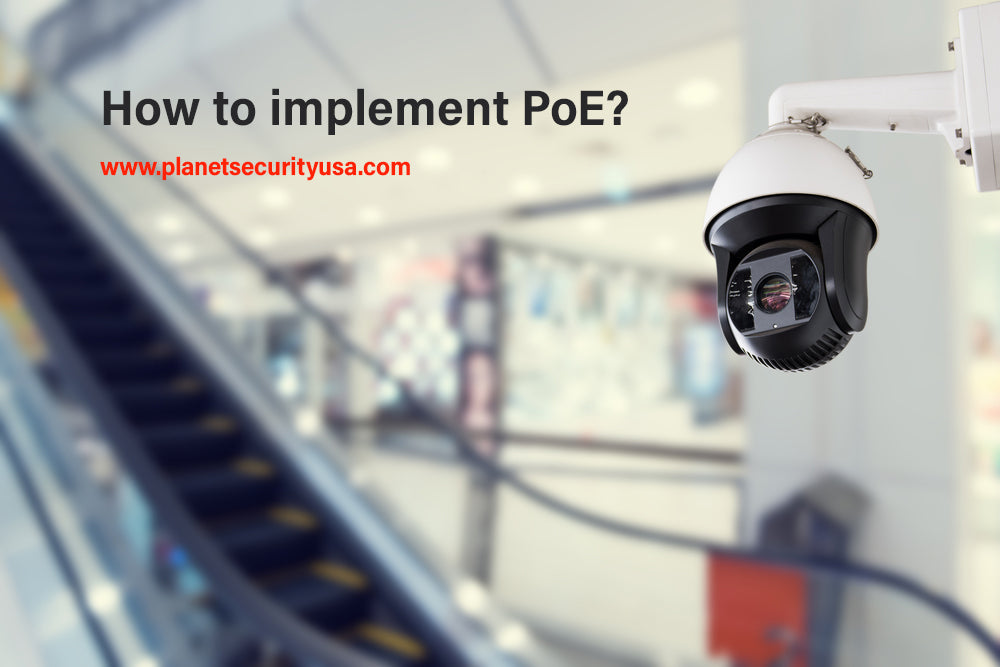You have no items in your shopping cart.

As technology advances, an increasing number of companies and government agencies are using Power over Ethernet (PoE) solutions to extend the distance between their network devices. PoE transmits both data and power over a single network cable, enabling significant savings in network installation and operation costs.
So here’s the quick take away answer on what is PoE, then we’ll dive into more of the advantages that would make you opt for PoE Video Surveillance Systems...
What Is POE?
When IEEE 802.3af - commonly known as PoE (Power over Ethernet) - was introduced more than a decade ago, and a new era in power supply for network devices began. The PoE (Power over Ethernet) standard is designed to simultaneously connect network devices to the power supply and transfer data.
PoE is used in virtually all telecommunications installations, including IP cameras, access points, and routers, as well as network switches and VoIP phones (Voice of IP phones).
In standard installations, the connection of devices commonly uses Ethernet cable UTP cat.5e twisted-pair cable. Due to the general availability and benefits of the possibility of connecting cameras to the network and power supply, PoE standard is especially appreciated by installers and users of network monitoring systems.
The current use and future of PoE
PoE technology provides a stable network connection and significantly lower installation costs, eliminating the need to route a separate power cord to each installation location of the network device. Products such as IP cameras, access points and VoIP phones are easier to install using PoE.
In recent years, a clear increase in the popularity of POE has been noted. According to marketwatch - “The market is primed to advance at a CAGR of 13% while earning revenues worth USD 1 billion in the forecast period”.
The use of this solution is widely promoted, and the largest growth (about 20%) is forecast on the Chinese and Indian markets. This is due to the fact that in that region, POE enjoys the greatest recognition.
What is more, many forecast a compound annual growth rate of 15 percent or more for the segment of powered devices, which include VoIP phones, access control systems and of course IP cameras amid the IP trend in video surveillance.
Currently, all network cameras have POE ports, through which they connect to the Internet. Cat5 or Cat6 cable is required for connection. This ensures the transmission of power and data.
Why Opt For PoE for Video Surveillance?
There are many advantages to PoE when it comes to the sphere of Video Surveillance. If you were to name the five key reasons to opt for PoE, it would probably be in the following order:
- Cost-effective - a PoE-based infrastructure will not only require fewer cables. First of all, it will relieve us from the need to install new electrical sockets to meet the energy needs of the growing infrastructure,
- Safety - the way PoE technology is designed maximises safety. The power supply is controlled in a way that allows us to avoid short circuits, power shortages or, on the contrary, overloads.
- Flexibility - no need for electricity allows us to place devices in optimal locations for their operation. We also have the possibility of free movement of already installed devices.
- Scalability - centralized power supply management (in PoE are responsible for network devices such as switches) allows the unlimited and parallel development of network and electrical infrastructure.
- Reliability - the aforementioned centralization of the power source in the switch allows us to take advantage of all the benefits of their redundancy - including the redundancy of power sources.
If you had doubts about whether it was worth implementing PoE, I hope that this short list dispelled them.
Future evolution of PoE
PoE simplifies installation by allowing you to transfer power and data over the same CAT5e cable. It does not affect Ethernet twisted pair communication and provides shorter design time and lower costs due to the elimination of cable parts.
Another reason to opt for PoE is that it offers the advantage of a centralized power source for easy management of power consumption across all Ethernet nodes. It also enables easy management of the backup power source for all connected systems.
With the development of PoE applications, the IEEE Standardization Committee has introduced new versions with greater available power, derived from the original 2003 IEEE 802.3af standard, which provided for the delivery of 15 watts of power per port.
The 2009 802.3at standard (also known as PoE plus) increases output power to 25 watts/port, and in the latest 802.3bt PoE update, this limit was increased to 100 watts.
It’s also worth noting that each PoE standard is backward compatible with previous editions. Since efficiency is crucial, PoE standards also specify the power that can be lost during power transmission along the shielded twisted pair CAT5e.
“PoE standard is backward compatible with previous editions”.
PoE vs other systems
This type of system offers a number of advantages over other available technologies in this field.
It’s important to be able to use VLAN (Virtual Local Area Networks). They allow administrators to create isolated networks without the need to physically separate the network architecture, which significantly increases management efficiency and security.
For example, VLAN networks allow to isolate the accounting department, warehouse and monitoring systems from each other. Isolating networks increases security and reduces the possibility of access to data in the event of an emergency.
Unlike competing systems, PoE allows for intelligent system management. Web Smart PoE Switches feature an intuitive graphical user interface that allows administrators to manage their network more easily via a web browser. Intuitive options and easy-to-understand features are particularly useful for novice network administrators.
Another valuable element is routine access to the switch, which improves management efficiency. Administrators, if necessary, can access the switch from any place and perform, for example, its restart - thus saving time associated with travel to the place. It is also possible to install a new PoE device and enable or disable the appropriate port in the switch directly from the place of installation, or remote management of VLAN networks and setting priorities for traffic.
A key characteristic of the PoE switch management function is the planning of energy consumption. PoE Switches display the current power consumption of the connected devices in real time, providing administrators with a powerful tool. This allows you to increase the number of connected devices without worrying about exceeding the available power.
Smart switches can alert the network administrator in the event of interference, interruption of the network cable or unusual activity, improving network security and ensuring long, error-free operation times.
Now you’ve come to understand the advantages to opt in over and above other systems, let’s take a quick look at how easy it is to implement - which is another advantage!
How to implement PoE?
UTP network cables consist of eight cables arranged in four twisted pairs. The PoE standard treats each pair as a single cable. In order for the electric current to flow freely, we need to create a closed-loop - hence, we need two pairs (four cables) to power the devices using PoE.
For Video Surveillance you need fast data. In the case of Fast Ethernet and lower standards, the matter is simple - they only need to use two of the four pairs for sufficient data transfer, leaving two unused pairs for use as the PoE. But what about Gigabit Ethernet, which uses all four pairs for data transmission?
It so happens that the current transmission does not interfere in any way with the data - so in such a case we can both power the device and transfer data to it at 1Gbps. The electrical energy fed to the UTP cable can be between 44 and 57 volts (48V is commonly used).
It’s low enough to still be considered safe to use and high enough to be able to carry an electrical charge and power the connected device effectively. At the same time, it’s a voltage that could damage a device that is not suitable for it. So, PoE has a built-in mechanism of detecting the connected device and determining what voltage it is able to take.
To conclude
To sum up, PoE technology combines a wide range of benefits for the user with ease of implementation. It’s certainly worth considering this option for anyone who plans to install a surveillance camera or other remotely controlled device that requires good quality data and power transmission, regardless of location.
On our website, you’ll find more information about this solution and a selection of products. We encourage you to familiarize yourself with our well-tailored offer.





















← Older Post Newer Post →
0 comments